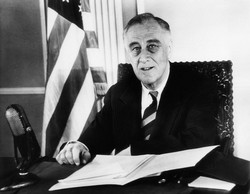Franklin Roosevelt As President
|
| updated |
Copy Link Code
|
 Before he became president, Franklin Roosevelt was heavily affiliated with the Democratic Party, first as a supporter of various candidates, then as a two-term Governor of New York. Much of the experience and exposure he gained as governor formed the man that would eventually be the longest serving U.S. President in history.
Before he became president, Franklin Roosevelt was heavily affiliated with the Democratic Party, first as a supporter of various candidates, then as a two-term Governor of New York. Much of the experience and exposure he gained as governor formed the man that would eventually be the longest serving U.S. President in history.
The presidency of Franklin Delano Roosevelt came at the height of the Great Depression in the mid-thirties. He would become the man who encouraged the American people to believe in themselves first and their country next. FDR, as president, promised prompt and vigorous action as he led the nation back from an economic cliff.
Herbert Hoover, a Republican, was president before Roosevelt. As part of his platform, Hoover had promised Americans that the nation was on the verge of ending poverty; the people believed that his election would bring prosperity, but the stock market crash eight months after Hoover took office sent the nation into a depression. His reluctance to use the federal government as a financial means out of the depression cost him the presidency.
The Franklin Roosevelt presidency began with a rapid response to the financial crises the Great Depression had brought on America. FDR also quickly began a connection with the people in order to gain their trust and support for the programs and policies he intended to implement; this relationship proved to be the foundation of all the Roosevelt presidencies. His "fireside chats" and his constant communication with them made the voters feel as if they were participating in governmental decisions. They trusted him and his actions regardless of his affiliation with the Democratic Party or his power over the Republicans who often disapproved of his presidency.
There were many accomplishments of FDR's presidency that stalled the Great Depression. In order to quickly bring about some financial stability, Roosevelt:
- Imposed a bank holiday to investigate the banks: The day after the Franklin Roosevelt presidency began, FDR declared a four-day bank holiday. During this period, all the banks were investigated; those that proved to be solvent were allowed to reopen, while others were closed until they could prove solvency. When one-thousand banks had reopened, FDR broadcast a fireside chat to tell the people it was now safe to put their money back in the banks, because their deposits would now be secure.
- Addressed unemployment with federal money: As president, FDR faced an unprecedented 25% unemployment rate. He recommended that Congress pass legislation to position the federal government as an employer through which several programs were formed to hire people to work on federal projects, such as building roads, bridges and government buildings. During Roosevelt's early days as president, he championed legislation that promoted reforestation and controlled agriculture supply and demand by paying farmers not to grow crops, because an oversupply keeps prices low.
- Abandoned the gold standard: Prior to the Franklin D. Roosevelt presidency, creditors were allowed to ask for payment in gold which resulted in people hoarding the natural commodity. FDR ordered that all gold, coins and certificates over $100 be exchanged for regular currency at the rate of $20.67 per ounce. This presidential order changed the standard of issuing money and provided some relief to the economy.
- Provided security for aging workers: Franklin Roosevelt's presidency is credited with passing the Social Security Act whereby workers and employers paid into a fund from which a retired worker could draw an "allowance" after retirement until his or her death.
- Stabilized industry: With the goal of eliminating unfair prices in an attempt to generate consumer spending, the Roosevelt presidency took steps to "price-fix" the market and hold businesses to controlled production.
- Instituted agricultural policies: One of the most effective programs of FDR's presidency was to pay farmers not to farm. The supply was so large and the demand so low because no one had any money that farmers were going broke growing food; these policies stopped that trend.
In his second term, the Roosevelt presidency instituted more programs to combat the waning depression, as well as solidifying some of the temporary measures put into place during the first term. By the time FDR's presidency approached the third term, tensions in Europe indicated war was on the horizon. Roosevelt encouraged the people to realize that the U.S. had to support freedom for the entire world. It was a prelude to disintegrating isolationism and a move toward supporting American allies if the war demanded it, even though most people opposed any U.S. involvement in another world war. During the fourth and final term of Franklin Roosevelt's presidency, his message changed to one of peace, unity and the importance of democracy. FDR's presidency ended within four months of this message when he died on April 12, 1945. He never saw the peace he so heartily advocated to have.
As president, Franklin Delano Roosevelt brought a nation through the worst period in its young history; the success of his presidency in approaching that challenge remains his legacy. Scholars, historians and politicians of today comb through his methods in search of answers to modern day problems similar to the ones FDR solved during the years of his long presidency.
